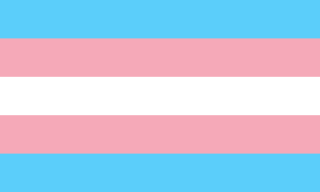Related Research Articles

Sexology is the scientific study of human sexuality, including human sexual interests, behaviors, and functions. The term sexology does not generally refer to the non-scientific study of sexuality, such as social criticism.

Sexual orientation is an enduring personal pattern of romantic attraction or sexual attraction to persons of the opposite sex or gender, the same sex or gender, or to both sexes or more than one gender. Patterns are generally categorized under heterosexuality, homosexuality, and bisexuality, while asexuality is sometimes identified as the fourth category.
Gender dysphoria (GD) is the distress a person experiences due to a mismatch between their gender identity—their personal sense of their own gender—and their sex assigned at birth. The term replaced the previous diagnostic label of gender identity disorder (GID) in 2013 with the release of the diagnostic manual DSM-5. The condition was renamed to remove the stigma associated with the term disorder. The International Classification of Diseases uses the term gender incongruence instead of gender dysphoria, defined as a marked and persistent mismatch between gender identity and assigned gender, regardless of distress or impairment.

The Kinsey scale, also called the Heterosexual–Homosexual Rating Scale, is used in research to describe a person's sexual orientation based on one's experience or response at a given time. The scale typically ranges from 0, meaning exclusively heterosexual, to a 6, meaning exclusively homosexual. In both the male and female volumes of the Kinsey Reports, an additional grade, listed as "X", indicated "no socio-sexual contacts or reactions" (asexuality). The reports were first published in Sexual Behavior in the Human Male (1948) by Alfred Kinsey, Wardell Pomeroy, and others, and were also prominent in the complementary work Sexual Behavior in the Human Female (1953).
Transvestism is the practice of dressing in a manner traditionally or stereotypically associated with a different gender.

Harry Benjamin was a German-American endocrinologist and sexologist, widely known for his clinical work with transgender people.
The World Professional Association for Transgender Health (WPATH), formerly the Harry Benjamin International Gender Dysphoria Association (HBIGDA), is a professional organization devoted to the understanding and treatment of gender identity and gender dysphoria, and creating standardized treatment for transgender and gender variant people. WPATH was founded in 1979 and named HBIGDA in honor of Harry Benjamin during a period where there was no clinical consensus on how and when to provide gender-affirming care.
The following outline is provided as an overview of and topical guide to transgender topics.
Gender expression, or gender presentation, is a person's behavior, mannerisms, and appearance that are socially associated with gender, namely femininity or masculinity. Gender expression can also be defined as the external manifestation of one's gender identity through behavior, clothing, hairstyles, voice, or body characteristics. Typically, a person's gender expression is thought of in terms of masculinity and femininity, but an individual's gender expression may incorporate both feminine and masculine traits, or neither. A person's gender expression may or may not match their assigned sex at birth. This includes gender roles, and accordingly relies on cultural stereotypes about gender. It is distinct from gender identity.

In behavioral science, androphilia and gynephilia are sexual orientations: Androphilia is sexual attraction to men and/or masculinity; gynephilia is sexual attraction to women and/or femininity. Ambiphilia describes the combination of both androphilia and gynephilia in a given individual, or bisexuality. The terms offer an alternative to a gender binary homosexual and heterosexual conceptualization of sexuality.
The American-Canadian sexologist Ray Blanchard proposed a psychological typology of gender dysphoria, transsexualism, and fetishistic transvestism in a series of academic papers through the 1980s and 1990s. Building on the work of earlier researchers, including his colleague Kurt Freund, Blanchard categorized trans women into two groups: homosexual transsexuals who are attracted exclusively to men and are feminine in both behavior and appearance; and autogynephilic transsexuals who experience sexual arousal at the idea of having a female body. Blanchard and his supporters argue that the typology explains differences between the two groups in childhood gender nonconformity, sexual orientation, history of sexual fetishism, and age of transition.

Sexuality in transgender individuals encompasses all the issues of sexuality of other groups, including establishing a sexual identity, learning to deal with one's sexual needs, and finding a partner, but may be complicated by issues of gender dysphoria, side effects of surgery, physiological and emotional effects of hormone replacement therapy, psychological aspects of expressing sexuality after medical transition, or social aspects of expressing their gender.
The classification of transgender people into distinct groups has been attempted since the mid-1960s. The most common modern classifications in use are the DSM-5 and ICD, which are mainly used for insurance and administration of gender-affirming care.

A transgender person is someone whose gender identity differs from that typically associated with the sex they were assigned at birth.

A transsexual person is someone who experiences a gender identity that is inconsistent with their assigned sex, and desires to permanently transition to the sex or gender with which they identify, usually seeking medical assistance to help them align their body with their identified sex or gender.
Anne Alexandra Lawrence is an American psychologist, sexologist, and physician who has published extensively on gender dysphoria, transgender people, and paraphilias. Lawrence is a transgender woman and self-identifies as autogynephilic. She is best known for her 2013 book on autogynephilia, Men Trapped in Men's Bodies: Narratives of Autogynephilic Transsexualism, which has been regarded by Ray Blanchard as the definitive text on the subject. Lawrence is one of the major researchers in the area of Blanchard's etiological typology of transgender women and has been one of the most major proponents of the theory. While Blanchard's typology and autogynephilia are highly controversial subjects and are not accepted by many transgender women and academics, some, such as Lawrence, identify with autogynephilia. Lawrence's work also extends beyond Blanchard's typology, to transgender women and to transition more generally.
Sexual diversity or gender and sexual diversity (GSD), refers to all the diversities of sex characteristics, sexual orientations and gender identities, without the need to specify each of the identities, behaviors, or characteristics that form this plurality.

The Transsexual Phenomenon is a medical textbook published by American endocrinologist and sexologist Harry Benjamin in 1966 with The Julian Press. The text is notable for its examination of transsexualism not as a psychological issue, but rather as a somatic disorder that should be treated through medicine. Benjamin argues that transvestism and transsexuality are a spectrum of conditions, requiring different treatments that ranged from hormone replacement therapy to surgical intervention.
Louise Lawrence (1912–1976) was an American transgender activist, artist, writer and lecturer. During the mid-20th century, she organized a network of gender non-conforming people across the US and abroad, and advocated for transgender issues. She was an early founder of the magazine, Transvestia. Academic and historian Susan Stryker wrote, "If there is an unheralded founder of the transgender community in the United States, it’s Louise Lawrence.".
The medicalisation of sexuality is the existence and growth of medical authority over sexual experiences and sensations. The medicalisation of sexuality is contributed to by the pharmaceutical industry, along with psychiatry, psychology, and biomedical sciences more generally.
References
- 1 2 3 Benjamin, Harry (1966). The Transsexual Phenomenon. The Julian Press, ISBN 9780446824262
- ↑ Heath, Rachel Ann (2006). The Praeger Handbook of Transsexuality: Changing Gender to Match Mindset. Westport, Conn. [u.a.]: Praeger. p. 4. ISBN 978-0-275-99176-0.
- ↑ Pomeroy, Wardell (1975). The diagnosis and treatment of transvestites and transsexuals. Journal of Sex & Marital Therapy Volume 1, Issue 3, 1975 doi:10.1080/00926237508405291
- ↑ Kumar, Anish; Amakiri, Uchechukwu; Safer, Joshua (15 February 2022). "Medicine as constraint: Assessing the barriers to gender-affirming care". Cell Reports Medicine. 3 (2): 100517. doi:10.1016/j.xcrm.2022.100517. PMC 8861822 . PMID 35243420.
- ↑ Coleman, E.; et al. (15 September 2022). "Standards of Care for the Health of Transgender and Gender Diverse People, Version 8". International Journal of Transgender Health. 23 (Suppl 1): S6-7. doi: 10.1080/26895269.2022.2100644 . PMC 9553112 . PMID 36238954. S2CID 252127302.
- ↑ Velocci, Beans (2021). "Standards of Care". TSQ: Transgender Studies Quarterly. 8 (4): 462–480. doi:10.1215/23289252-9311060. S2CID 244064667.
- ↑ Frayser, Suzanne G.; Whitby, Thomas (1995). Studies in Human Sexuality: A Selected Guide. Englewood, Colo.: Libr. Unlimited. p. 368. ISBN 978-1-56308-131-6.
- ↑ Ekins, Richard (2005). Science, politics and clinical intervention: Harry Benjamin, transsexualism and the problem of heteronormativity Sexualities July 2005 vol. 8 no. 3 306-328 doi: 10.1177/1363460705049578
- ↑ Hansbury, Griffin (2008). The Middle Men: An Introduction to the Transmasculine Identities. Studies in Gender and Sexuality Volume 6, Issue 3, 2005 doi:10.1080/15240650609349276